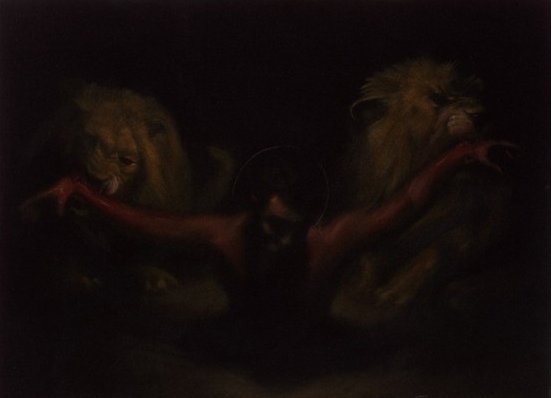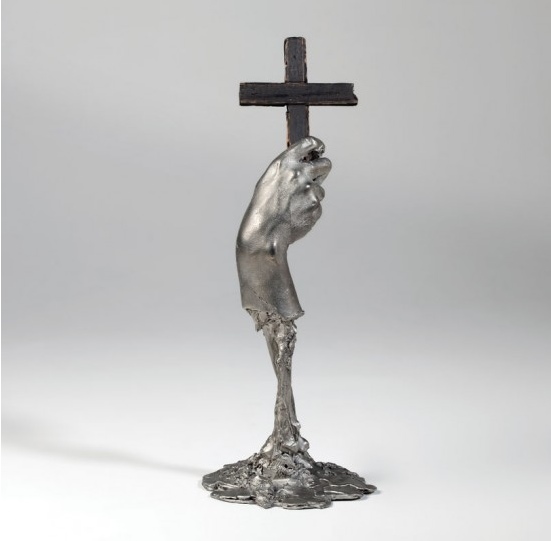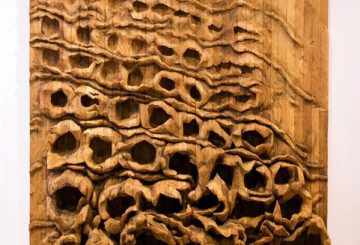Sharne Wolff ponders whether it’s thumbs up – or down – for Leslie Rice’s second solo at Jan Murphy Gallery…
Leslie Rice likes to work on the dark side. His new works at Jan Murphy Gallery in Brisbane are so dark & hard to photograph that when the Gallery released the images on its website, it fielded comments from well meaning clients about whether there was something wrong with the internet page ‘…all I can see is a black space’. On driving past the Gallery, all that is visible are black images in beautiful black frames.
But, oh how things change when you see the works up close.
Acrylic on velvet, 53x73cms
Last week on The Art Life website, Carrie Miller examined the demise of the ‘white cube’ gallery in her article Farewell White Cube, Hello Brave New Internets. Although there are undoubtedly many positive impacts of the internet on the art market both for artists and for dealers, this is one show where seeing the work in the real is virtually a necessity for anyone seriously interested in either buying or viewing the artist’s work.
Rice graduated from the National Art School in 2005 and has kept somewhat of a low profile in an exhibition-sense since then while he leads a busy double life as a tattoo artist and lectures at the National Art School. Although he has appeared in several group shows, this is only his second solo show since winning the Doug Moran National Portrait Prize in 2007. Rice has, however, popped up as a finalist in numerous prizes in the last five years and in an interesting twist, was a finalist in the Archibald Prize in 2008 with one of two portraits of fellow artist Adam Cullen, one of the judges of the Doug Moran the year before. At the time Rice won the Doug Moran he was reported as saying he intended to use the $100,000 prize to open a tattoo studio in Sydney which he has now gone on to do. Depending on the size and intricacy of the design required you might wait up to 18-months wait for one of Rice’s tattoos. In between working in his studio and teaching at the NAS, Rice paints extraordinary pictures.
Entitled Christian Martyrs of the Roman Colosseum this show is all about theatre and spectacle. It’s about drawing in the viewer into the paintings and like the roman Colosseum, it’s also about audience reaction. Each work (apart from one sculpture) is painted in acrylic on black velvet, apparently a notoriously difficult surface on which to paint because of the exacting nature of the work, not unlike the technical skill required with the tattoo needle. The framing of the works in black frames with perspex gives the paintings a sort of holographic quality that, depending on where you are standing in the gallery, can make the perspex seem to disappear altogether.
Each painting in the show is given a name that includes the title of the show and then a number, a reference to each martyr. Although Rice says he does some reading and research, each of the deaths is actually an imagined scenario. Christian Martyrs of the Roman Colosseum (#8) is, on the day I see it, particularly well lit and rather confronting with the symmetry of two lions, one on each side of the picture, each approaching the viewer with a bloody arm in their teeth. On the other hand, the lion cub in Christian Martyrs of the Roman Colosseum (Remnant of #13) actually seems rather sweet at a distance. When you approach closer to the picture you realise the cub is chewing on a human arm. Suddenly the eyes of innocence become more sinister.
Pewter and hand painted wood, 54x22x22cms.
The work is reminiscent of Italian Baroque painters like Caravaggio and Artemisia Gentileschi in the sense of drama and in the darkness it employs as one of several techniques to lure the audience. It has been said of Caravaggio that he ‘put the oscuro into chiaroscuro’ to create extreme tenebrism (or ‘darkness’) but even he often used strong shafts of light. Rice is not interested in the background except for its ability to be darkness itself – a means to convey the horror of a grisly death, to create more gruesome scenes and to conjure fear in the shadows. By forcing you to look into the black paintings, the artist has given them that horror movie quality – where you want to see what happens next although it would be safer to hide under the seat or, better still, to have stayed home in front of the TV. The artist also employs rich blues, oranges, flesh tones and a sparing use of white to make his human and animal subjects come alive at the very time of death.
Rice is apparently fascinated by martyrdom, and with death in general. He is also making comment on the death of art itself. According to Rice, his death metaphor ‘questions the notion that painting and even Art itself has died on one or more occasions’ and specifically questions ‘the relevance of art in the era of late capitalism’. Of course themes of religion and mythology also run through the show, including the solo sculpture entitled ‘Colosseum Relic’ where a hand rises from the earth (from the dead perhaps) holding a wooden cross.
Like Caravaggio, Rice is also interested in mixing the two worlds of ‘high’ or ‘fine’ art with that of ‘pop’ art or the art of the people. Caravaggio used characters from the streets in a style sometimes termed ‘radical naturalism’ – his subjects were people literally from the streets – dirty fingernails, greasy hair and dishevelled clothes all included in his art. Rice takes on a similar idea and although his human subjects are not of today’s streets, the use of lions, tigers, vultures, skulls and dismembered body parts are just as likely to be found in the tattoo studio, in posters, and on the bodies of the artist’s clients and friends as in his paintings. The use of velvet as an additional tacky element in this portrayal of the pop or perhaps the street, adds to the authenticity of the story. This whole idea becomes interesting when it raises questions about vulgarity and good taste.
Although the images are rather chilling on the whole, I may be wrong, but I formed the impression that the artist does not take himself too seriously, and that there is an element of farce in the ‘over the top’ nature of the spectacle, especially in its contemporary setting. To some extent Rice is pushing the envelope here and it will be interesting to see how far he can go.
Leslie Rice
Christian Martyrs of the Roman Colosseum
Jan Murphy Gallery
Until 18 December 2010.




Pingback: Review of Les’ painting show
Pingback: The Art Life 2010 Part 1 | The Art Life
I think this work is so different and amazing. He is one of my teachers and is a wonderful mentor. He gives you freedom of expression and I would not have known so much about his work if I had not read this article, and the Moran Prize winners. A wonderful insight. Thank you.